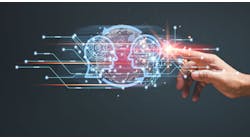Dave Perkon is technical editor for Control Design. He has engineered and managed automation projects for Fortune500 companies in the medical, automotive, semiconductor, defense and solar industries.
In its simplest form, the Internet of Things (IoT) is the connection, and the cloud is a remote hard drive and some useful applications, but, when looking at the data, things get complicated. There will be huge amounts of data stored securely in the cloud as a result of the IoT, and the trick will be use and analysis of the information, not the connection and storage of it.
The technology of the Information Age is the IoT, the cloud and big data. These three technologies work together, and, in the near future, we will have another name for it all. One thing it cannot be called is the black hole of data. It needs to create stars, not eat them to realize the efficiency and productivity improvements everyone is claiming.
The Autodesk IoT VIP Experience session at Autodesk University 2015 (AU 2015) in Las Vegas shed some light on the IoT, cloud and how the data can be used. The session basically launched Autodesk's IoT business and how the future of IoT fits into the future of making things.
What does IoT mean and why is it important? Autodesk's CEO Carl Bass discussed how everything will have an IP address, everything will be addressable. And it will be monitored and controlled. He gave three good examples on how it can actually be used. The first is software, which will change the experience of the product itself; adjusting the product for the users, in real time, is a big deal. Electromechanical systems driven by software will be a defining characteristic.
A second use is understanding the performance of the products when in the field, doing preventive maintenance, for example—real recorded data. "Performance is not what someone thinks about a product, but real data from the product or machine," said Bass. "It requires collecting everything, not just samples, and from every device or sensor that's on the machine. Think of it as a machine-as-a-service where the manufacturer uses the information itself to give the end user what it really wants, which is uptime instead of something that may stop working and will need a maintenance contract."
Also read: Will the next age be the Human Internet of Things?
The third one is actually using the feedback. "If we are gathering sensor input, we can feed it back into the design process," said Bass. "Version two will then use real data to drive its design. The design won't be perfect the first time, but the data defines the lessons learned, and they are applied in an improved design. The sensors and the data will be a part of the design process."
How do you get the data? Well, Bryan Kester, head of IoT at Autodesk and formerly CEO of SeeControl, announced Autodesk SeeControl, an IoT cloud service platform company allowing users to collect, analyze and use data from remote products. It looks like an easy-to-use way to optimize existing products and equipment by capturing the information or, better yet, intelligence required.
Before discussing SeeControl at this AU 2015 session, Kester provided an IoT definition, in layman’s terms, that even your mother-in-law may understand. "The IoT refers to the growing ecosystem of physical devices embedded with sensors and software that connects them to the Internet and to each other,” he said. “It is having a massive impact on not just consumer products but also on machine manufacturers who need to meet their customers’ expectations for online services."
Kester also notes the term IoT has been around since the late ’90s. "Many think the IoT is a ridiculous term because it doesn't really mean anything as things will just be connected,” he said. “Autodesk SeeControl targets the connection between the products and their customers. It uses the Industrial Internet of Things (IIoT) where data is captured, analyzed and managed. It's a point-and-click approach to IoT and helps manufacturers make smart, connected products or machines."
Autodesk sees the IoT helping to develop products and industrial machines and equipment, and it is focusing on the machines that run the world around us. The machines you may not notice until production stops.
IoT broadly covers just about everything related to computing. "Little remote computers and sensors, a network in the middle, and on the backend, in the cloud, is a huge pile of software collecting and analyzing a massive amount of data," said Kester. "Industrial equipment creates maybe half a megabyte of data to several gigabytes a day. With a plant full of machines, that's quite a bit of network bandwidth and computer horsepower. It’s pushing the edge of computer science when we start filling factories with IoT."
Moore's law of computer cost and power and Metcalfe's law of network cost and power are converging at a moment where you connect just about anything, and it is making the IoT a guaranteed reality. "The cost of computers is low enough now that it won't just be a sensor, but a full-blown computer in just about anything—complete with networking and even cellular connections," said Kester. "Your machines will be connected on cellular friends-and-family plans. Connecting a thousand machines on the same data plan is real."
SeeControl software is the fastest growing IoT cloud software service in the world, and it has some unique characteristics. For one, is it is completely native to the cloud. It doesn't need to be supported on-site or hosted in a cloud-based fashion. It's also a no-coding platform, so a wide range of users can be productive with the software in a short period of time. The machine-to-machine protocols are built in, so it is device- and communication-protocol-agnostic and not tied to a single standard.
The bottom line is you have to collect the data and use it. You are not going to want to write custom code to access and analyze the data. It is probably a good idea to see what's out there in the market to make your data successful. If you can start collecting the data and extracting in a few days to make machine, product and business decisions, you'll be connecting with success.
Homepage image courtesy of Sira Anamwong at FreeDigitalPhotos.net





